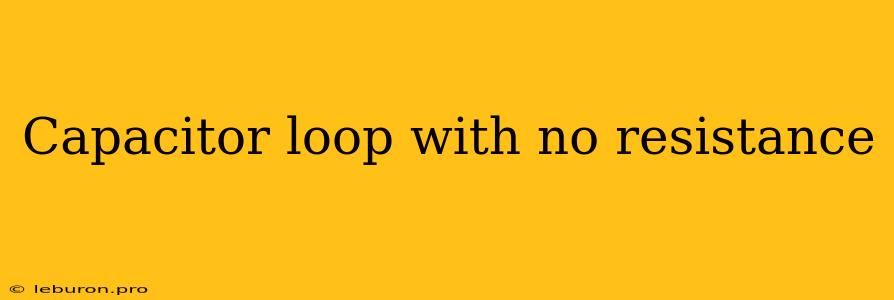Capacitor Loop with No Resistance: Exploring an Idealized Circuit
The concept of a capacitor loop with no resistance presents an intriguing scenario in the realm of electrical circuits. While purely theoretical, this idealized situation allows us to delve into the fundamental behavior of capacitors and their interaction with energy storage and transfer. Understanding this concept provides valuable insights into the functioning of real-world circuits, where resistance, though always present, can often be minimized to achieve desired outcomes.
The Idealized Circuit: A Theoretical Exploration
Let's consider a simple circuit consisting solely of a capacitor (C) connected in a closed loop. Crucially, we assume zero resistance in the connecting wires and the capacitor itself. This means that no energy is dissipated as heat during the flow of charge.
The Charging Process: A Brief Look
Imagine we connect this ideal capacitor loop to a voltage source. Due to the absence of resistance, the capacitor will charge instantaneously. The voltage across the capacitor will rise rapidly, reaching the same value as the voltage source. This rapid charging is a direct consequence of the zero resistance condition.
Energy Storage and Discharge: The Heart of the Matter
The key characteristic of a capacitor is its ability to store electrical energy. In our idealized loop, as the capacitor charges, it stores energy in the electric field created between its plates. This energy is directly proportional to the square of the voltage across the capacitor and its capacitance:
Energy (E) = 1/2 * C * V²
With no resistance to impede the flow, once the capacitor reaches full charge, the energy remains stored within the electric field. The absence of resistance ensures that this stored energy cannot dissipate as heat.
The Discharge Process: A Continuous Loop
Now, let's disconnect the voltage source. In a normal circuit, the stored energy would gradually discharge through the resistance, causing the voltage to decrease over time. However, in our ideal, zero-resistance loop, there's no path for the energy to dissipate.
The capacitor, therefore, remains charged indefinitely. The voltage across the capacitor remains constant, and the stored energy stays unchanged. This idealized scenario highlights the fundamental nature of capacitors as energy storage elements.
Real-World Implications: Minimizing Resistance
While the concept of a capacitor loop with no resistance is purely theoretical, it offers valuable insights into the behavior of real-world circuits where resistance can be minimized. Here's how:
1. High-Frequency Applications: Capacitors Shine
In high-frequency circuits, capacitors play a crucial role in filtering and energy storage. Minimizing resistance in the circuit path is essential to reduce energy losses and maintain signal integrity. High-quality capacitors with low equivalent series resistance (ESR) are specifically designed for these applications.
2. Energy Storage Systems: Minimizing Losses
In energy storage systems like batteries and supercapacitors, minimizing resistance is crucial for maximizing efficiency. Lower resistance translates to less energy lost as heat during charging and discharging, leading to higher energy storage capacity and longer operating life.
3. Resonant Circuits: Tapping into Natural Frequencies
Resonant circuits, where capacitors and inductors work together to achieve specific frequencies, benefit from minimizing resistance. Low resistance allows for more efficient energy transfer and sharper resonant peaks, crucial for applications like radio frequency (RF) oscillators and filters.
Beyond the Ideal: The Reality of Resistance
It's important to remember that resistance is a fundamental property of all materials. While we can strive to minimize it, completely eliminating it is impossible.
1. Capacitor's Internal Resistance: ESR
Every capacitor, even those designed for low resistance, possesses a small amount of internal resistance known as ESR. This internal resistance plays a role in energy dissipation, affecting charging and discharging times and efficiency.
2. Wire Resistance: An Unavoidable Presence
The connecting wires in any circuit contribute to the overall resistance. While wire resistance is often small, it can become significant in high-frequency applications or circuits with long wire lengths.
3. Practical Considerations: A Balancing Act
In practical circuit design, the goal is to minimize resistance as much as possible. This often involves selecting high-quality components, optimizing circuit layouts, and minimizing the length of conductors. However, there's always a balance between achieving low resistance and other factors like cost, size, and complexity.
Conclusion: From Ideal to Practical
The idealized concept of a capacitor loop with no resistance provides a powerful tool for understanding the fundamental principles of capacitor behavior and energy storage. While impossible to achieve in reality, this theoretical exploration highlights the importance of minimizing resistance in practical circuits for optimal performance and efficiency. By carefully selecting components, optimizing layouts, and considering the inherent limitations of resistance, engineers can design circuits that leverage the full potential of capacitors while minimizing energy losses.
